





This report was supposed to appear several times over the past few years. Time and time again, nothing came of it. It almost seemed as if the west coast of Corsica was refusing to be explored under sail. Coming from Elba as well as from the French coast, the journey proved to be too far. At least if you are travelling on a charter boat that you have only rented for a week or ten days. Another attempt from the north-east of Sardinia failed due to the mistral that hit the crew in the notorious Strait of Bonifacio. No way round.
But now it should finally work out. By starting directly where we first wanted to sail in previous years: on the side of Corsica facing away from the Italian mainland. More precisely: in Ajaccio. There we board the "Agrasot", a Dufour 460 GL from Dream Yacht Charter.
Once again, however, there is no guarantee that our plan will succeed this time and that we will finally be able to sail to the spectacular west of Corsica with all its rocky shores, secluded anchor bays and old towns. We are late, at the end of October. Actually good conditions for a calm post-season trip. But the risk of strong winds is high. Not to mention a full-blown mistral. The water temperatures this autumn are far too high. Great for swimmers - worrying for sailors. There is a lot of energy in the sea. This can cause violent weather turbulence. Meteorologist Dr Michael Sachweh recently warned on YACHT online: "The potential for severe autumn storms is high."
The most recent example: 18 August 2022, in the middle of the summer, an exceptional storm brewed over the western Mediterranean, which hit Corsica with tropical and traumatic wind speeds of up to 230 kilometres per hour, costing the lives of nine people on the island and several owners on the west coast their boats. On YACHT online, a young owner described how his catamaran was overturned at anchor by brutal gusts. Fortunately, the current weather forecast promises that things can be different, very different. Moderate winds and plenty of sunshine are forecast for the coming week.
Provisions at the Ajaccio market
It's Saturday morning. And market day in Ajaccio. A feast for the senses and practical in terms of provisions. Tangerines, wild boar sausages, baguettes, ham, cheese of all kinds, olives - everything is ready to be tasted and tempted. Shopping could hardly be better, albeit with the consequence that the ship's coffers are at low tide afterwards.
In the afternoon, the "Agrasot" is ready to set sail - a first trial run with the main battened down. That's good. Despite a moderate breeze in the Gulf of Ajaccio, the yacht starts right up. We set course for the "bloody islands", the Îles Sanguinaires, which lie off the Gulf of Ajaccio. As far as the gruesome name is concerned, you can choose a variant for the derivation. The romantic version: the rocks turn a dark red colour at sunset. The perhaps more realistic explanation is that the name commemorates the many dead sailors whose ships were wrecked on the shores before a lighthouse was built.
Legend has it that Christopher Columbus came from Calvi. They have erected a monument to him at the citadel
In the south of the main island, there is only one jetty for excursion boats. An anchorage is marked on the charts, but there is no sandy bottom at a depth of four to five metres. There are only stones. And so the first day ends in a bay on the west coast of Corsica, not far from Capo di Feno. Unfortunately, the restaurant there with a view of the islands is already closed when we arrive. It's only 6 pm and we don't even get an aperitif. A pity really, but probably due to the low season.
White beach in the Gulf of Peru
The next day, Sunday lives up to its name. With southerly winds to boot. Ideal for sailing further north. In contrast to the Gulf of Ajaccio, the buildings on the shore suddenly become sparse. Nature takes over. One bay follows the next. Unlike in Sardinia, there are always mountains in the hinterland. The highest, Monte Cinto, rises 2,706 metres into the sky.
Behind Cargèse on the Gulf of Sagone, we discover the Gulf of Peru, which is basically just a bay. The white beach at its apex is perfect for anchoring. There is hardly a better way to spend the afternoon, including a visit to a beach bar. Cargèse, on the other hand, is a good place to spend the night. Especially as an offshore sea wind would put the boat at right angles to the swell. And not everyone on board has such thick sea legs that they would find rolling around at night sleep-inducing.
We can go alongside in the small harbour basin without any problems - this time a positive circumstance due to the low season. On the way into town, we come across the first storm victim of 18 August: a catamaran called "Take Off" is lying heavily damaged behind the harbour pier in the no stopping zone. Even with its two engines and full throttle, the crew was unable to keep the ship clear of the shore, the harbour master tells us.
The Gulf of Porto, the most beautiful part of western Corsica
Day three brings us an offshore south-easterly wind and thus an express trip into the Gulf of Porto. This is probably the most spectacular stretch of coastline in western Corsica. As soon as we enter the gulf, the wind turns into a downdraft. Not a trace of cover. A reef wouldn't be a bad idea. But too late. Alternatively, we drop off and let the gusts take us slightly off course. There is enough room to leeward. And the diversions gives us plenty of sailing speed and fun.
The further we head towards Porto in the Gulf, the tamer the gusts. In the afternoon, we find ourselves in a picture-book bay with a few fishermen's huts on the shore, Anse de Ficajola. It is located at the foot of the Calanches de Piana, a bizarre rocky landscape that has been a Unesco World Heritage Site since 1983. We even put up with a few gusts of wind overnight to enjoy the scenery - especially as, according to a snorkelling neighbouring skipper, our anchor is lying more firmly and deeper in the sand than we would like, and directly over the chain of a disused Muring harness. Annoying. But it can't be helped. The problem is put off until tomorrow, only to turn out not to be a problem at all.
Effects of the storm can still be seen in Corsica
We motor to Porto for a flying visit. Petit Porto would be more correct. Despite the promising name, the harbour is too shallow for sailing boats. We have to use the dinghy, only to realise that we're missing out: You don't really miss anything at the tourist hotspot and starting harbour for various excursion boats. So we weigh anchor again and continue on to Girolata with a fresh baguette. This was the epicentre of the severe storm on 18 August. Wrecks lined the shore in rows. Two months later, most of it has already been cleared up. There are no more stranded yachts to be seen. Only the arrangement of the mooring buoys in the popular bay looks rather chaotic.
The young man who asks about our draught, lashes us between three buoys and even offers us a fourth, gives us a harrowing eyewitness account when we pay at the harbour office. You can still see his shock. He tells us about a white wall that came towards them in the morning. The furling jib on a classy black yacht, which was moored on the very outside, came undone. The ship then drifted through the buoy field, tearing several other yachts from their moorings and leaving them stranded. In front of the cliffs, crews, including some families, jumped from their boats into the water in panic. Nobody was able to help. It was impossible to stay on their feet in the wind. They could only take cover to avoid being hit by flying debris.
After just under an hour, the spook was over. The result: chaos, many helpless people and one dead. As he reports this, he points to the photo of a fisherman on the outside of the office. The young harbour master's report ends with the sentence: "It was a trip to hell!" Even now, a good two months after the terrible events, there is still something oppressive about the beautiful bay. Apart from us, there are only three other boats hanging from the mooring buoys, their chains still knotted underwater. They will soon have to be replaced with heavier gear.
"In case something like this happens again," says the harbour master. "The water temperatures are still far too high for October." Which probably also explains the numerous jellyfish that are appearing more frequently in some places and sometimes make swimming impossible.
Jellyfish only occur sometimes- but then in large swarms
We leave Girolata at sunrise the next morning. As soon as we have left the fortress behind, the coast begins to glow in the first sunlight. The Scandolo nature reserve lies ahead of us. Fishing, diving and anchoring overnight are prohibited. But marvelling is allowed. We sail through the narrow and shallow passage of Gargalu in moderate conditions with only a genoa. The massive rock faces are close enough to touch. We then drop anchor in the Marina d'Elbo for breakfast. We are the first and only boat in this spectacular bay. A catamaran with children on board turns right back into the water: too many jellyfish in the water. Next bay, new bathing spot. Fortunately, the animals only appear in swarms in some places.
The table in the cockpit is just being set when a park ranger in a rubber dinghy comes by and checks it. The man wants to know whether we have spent the night here, which we can answer in the negative with a clear conscience. As proof, I offer to show him the mooring invoice from Girolata. But the ranger waves us off and says: "Bon journée, messieurs, au revoir!"
Au revoir. It's so easy to say. It's hard to say goodbye. We would like to go on a shore excursion now, but even that is forbidden in the nature park. As an alternative, we set sail and head for Calvi, the northernmost point of this journey. According to legend, this is the birthplace of Columbus. A worthy turning point. Once we turn into the Gulf of Calvi at Punta Revellata, the old citadel from the 13th century appears in front of the bow. The defence walls merge seamlessly into the rock. Slightly off to port, the wide bay of the Gulf of Revellata opens up, where up to 300 yachts are moored and anchored in summer.
We announce ourselves by phone to the harbour master, who assigns us a place. First row. With a view of the fortress from the cockpit. Until a Sunreef 90 moors on the other side of the jetty and takes away our view and the sun. But never mind, the sight needs to be explored on foot anyway.
Finest coffee sailing in shorts
The next morning we set off again before the excursion boats. The fine weather continues. On the contrary. The wind shifts to a northerly direction just in time for the return journey. We enjoy the finest coffee sailing in shorts. It could be a lot worse. Like back in April 2004, the day I lost my seasickness: my first job for YACHT as a sailing and writing skipper in one. Overnight, winter had returned to Corsica. The sea was grey and high and reflected by the steep coasts - extremely choppy. Much like my mood at the time. It was nerve-wracking sailing between mountains on water and on land, some covered in snow, others in foam. But: those unforgettable colours when the sky opened up later with a mistral - amazing!
Here and now, same place, different wave. Corsica in October 2022 - no comparison. Sailing off the west coast is and remains as varied and exciting as the island and the sailing itself.
Harbour and anchor tips for Corsica
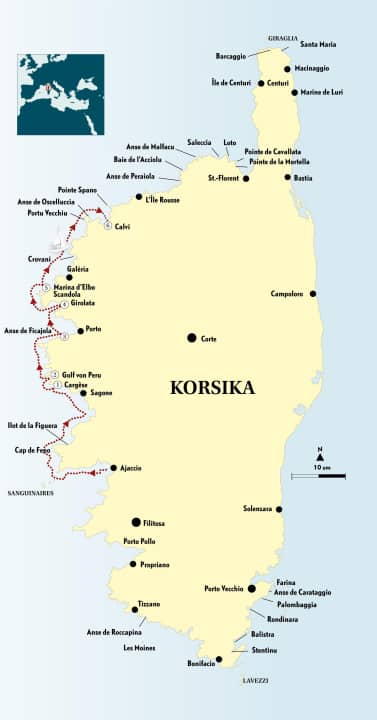
1 Cargèse
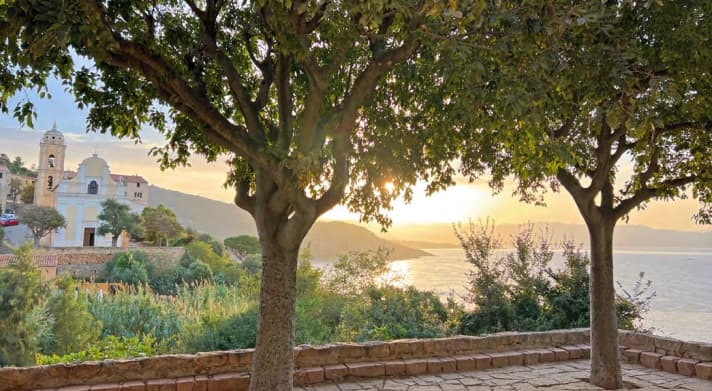
Small harbour at the foot of the village. A morning climb up to the two churches and their squares is recommended, the view is definitely worth it. If you do your shopping at the Spar supermarket afterwards, you can have the goods brought to the boat free of charge. Just ask at the checkout.
2 Gulf of Peru
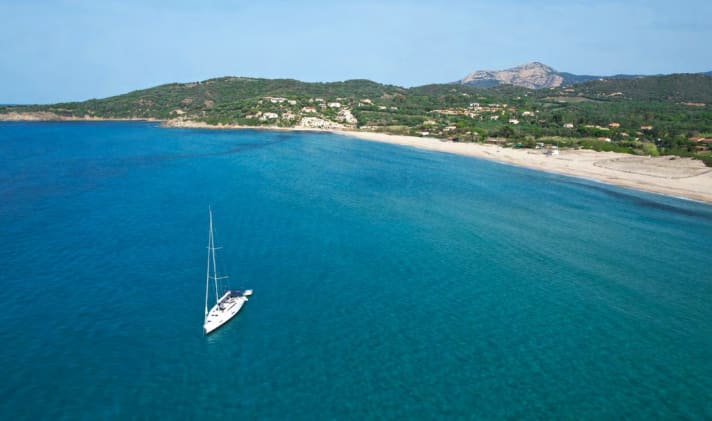
An anchorage bay made for sailors: a beautiful sandy beach with water colours reminiscent of the South Seas. On the shore, you can enjoy a delicious lunch at the small beach bar "Paillotte a Piaghja". We were particularly fond of the dessert, the crème caramel.
3 Anse de Ficajola
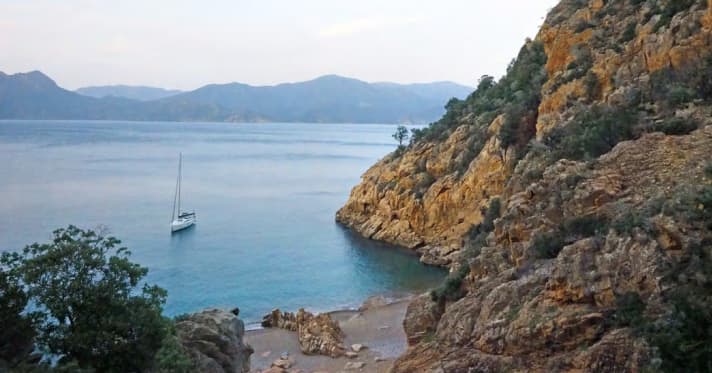
Picturesque bay in the Gulf of Porto just below the village of Piana. It can get crowded here in summer. Take care when dropping anchor. A crew member should use a snorkel and goggles to scout the seabed for old Muring remains.
4 Girolata
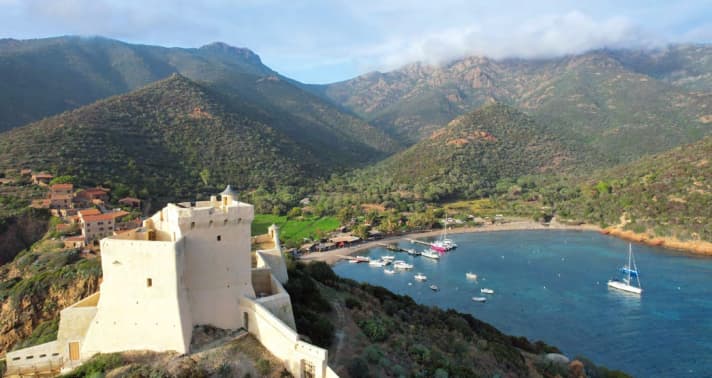
The bay below the old fort is sheltered and can only be reached from the sea. Mooring is at mooring buoys, which were still lying all over the place after the storm in August, but are to be replaced and made stronger for the next season. There is a restaurant, but only limited catering facilities.
5 Marina d'Elbo
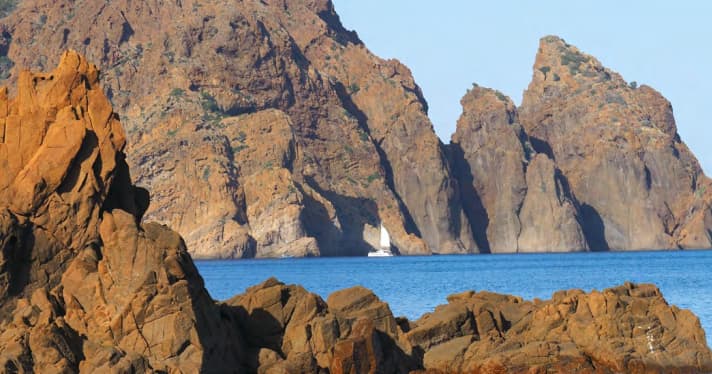
Situated in the Scandolo nature reserve. The area is heavily frequented by excursion boats. Angling, fishing and flying drones are prohibited. Anchoring is permitted between sunrise and sunset; it is controlled.
6 Calvi

The approach alone is impressive once you have passed Punta Revellata. You can enter the harbour just below the bay or anchor off the long sandy beach. In the evening, head to "Chez Fifi" in Rue Alsace Lorraine for inexpensive fish dishes, local specialities and Corsican music.
Area information Corsica
Charter
We were travelling with a Dufour 460 GL from Dream Yacht Charter. Depending on the season, the boat costs between 1,590 euros in April and 6,865 euros in August. Information and booking: Phone 0931/30 69 90 40, CHARTERBAR-YACHTING.COM
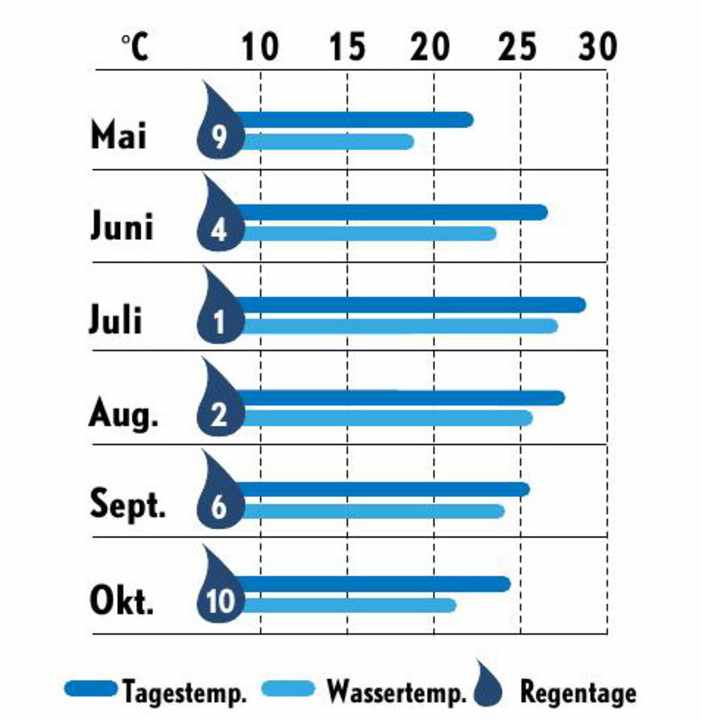
Navigation & Seamanship
Corsica, the fourth largest island in the Mediterranean, is characterised by a central high mountain range. The west coast in particular is certainly not an area for beginners, as it lies in the area of influence of the Mistral. There are hardly any harbours between Ajaccio and Porto. The coast is predominantly rocky and the swell is strongly reflected. The main problem on the west coast is therefore that there are only a few usable anchorages where you would be sufficiently protected from the strong swell. If the forecast is favourable, these places are also quickly occupied, even if the number of yachts on the west coast is generally lower than in the south or south-east of the island, for example. However, if you are lucky with the weather, you will be rewarded with one of the most beautiful stretches of coastline in the entire Mediterranean.
Wind & Weather
There are essentially four different weather constellations for Corsica: In summer, pronounced high-pressure conditions with sea and offshore winds at night predominate. Disturbances occur more frequently in spring and autumn due to the mistral. It blows strongly from the Gulf of Lion and can create a considerable wave off Corsica. A Genoa low, on the other hand, brings uncomfortable weather to the north of Corsica in particular. An area of low pressure to the south is accompanied by poor visibility and rain in the west. However, it rarely lasts longer than two or three days.
Literature & Charts
- For the shore excursion: "Corsica", 21.95 euros, Baedeker.
- Cruising guide: "Corsica, Sardinia, Elba" 39.90 euros,
- Map: "FR 11, NV. Atlas France-Corsica" , 64,99 Euro

